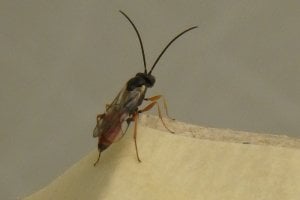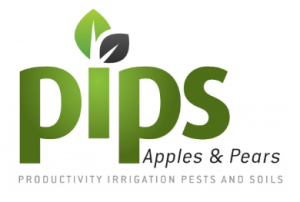A newly imported Mastrus ridens colony may hold the key to future successful establishment of this parasitic wasp, an important biological control tool in the long-term management of codling moth.

Mastrus ridens
The new Mastrus ridens (Mastrus) colony, combining lines of the wasp from Chile and Kazakhstan, has been released from quarantine and transferred to Agriculture Victoria’s Tatura Smartfarm where it will be mass-reared in time for limited spring 2022 releases.
Providing growers with the tools they need to implement long-term, sustainable control of key pests such as codling moth is a priority of the research being undertaken by Agriculture Victoria as part of the apple and pear levy-funded Productivity, Irrigation, Pests and Soils (PIPS) Program. Codling moth is a serious pest of pome fruit production worldwide, and the most important pest of apples and pears in Australia. Control measures are necessary to prevent serious crop damage, with season-long control often relying on the regular application of insecticides. Synthetic insecticides have the potential to disrupt integrated pest and disease management (IPDM) programs, leading to secondary pest outbreaks. Effective biological and cultural controls, used in conjunction with mating disruption, and supplemented by IPDM-compatible insecticides, can provide the foundation of a sustainable and fully integrated pest management system (Williams and Villalta 2021).
A key component of IPDM is the use of natural enemies, also known as biocontrol agents, to regulate pest populations. An important biocontrol agent of codling moth is Mastrus. Mastrus is native to Central Asia where it has evolved as a highly specialised natural enemy of codling moth. Mastrus actively searches for and parasitises cocooned fifth instar larvae, reducing the abundance and spread of subsequent generations of the pest. It is this highly targeted search and destroy strategy that makes it so useful in IPDM; it can locate and control codling moth larvae both within the orchard and in the surrounding landscape without harming native and beneficial insects (Aldred 2013; Lefoe et al. 2013). Targeted control of overwintering larvae in the landscape, for example in unmanaged trees or neglected situations, is especially important for reducing propagule pressure and re-infestation of otherwise well-managed orchards. It is not surprising then, that Mastrus has been introduced to at least half a dozen apple and pear producing countries, including Australia (Retamal et al. 2016).
Optimising the benefits of biological control
The first release of Mastrus in Australia occurred in Merrigum, Victoria, in 2014. Subsequent releases were made in the main apple and pear growing regions of Victoria, New South Wales, Tasmania, South Australia and Queensland. Follow-up monitoring of orchards in each state found Mastrus has considerable promise for reducing codling moth populations in the season following release (Williams 2019). However, there is no evidence that Mastrus has established permanent populations in these orchards or surrounding areas. In its absence, codling moth populations can rebound to previous levels. One solution is to commercially produce Mastrus and re-release it into orchards at regular intervals: an approach known as augmentative biological control. However, if Mastrus can establish permanent populations in or around Australian orchards, as it has in some countries, then continued releases would be unnecessary and ongoing costs to growers would be negligible. This second approach is called classical biological control, and successful classical biological control programs generate a high return on investment because the benefits accrue year on year.
Can classical biological control work in Australia?
 The current PIPS3 Program project Strengthening cultural and biological management of pests and diseases in apple and pear orchards (AP19002) aims to assess establishment of Mastrus and identify reasons for the apparent low establishment rate in Australia. One crucial piece of evidence was uncovered by researchers at the Pontifical Catholic University of Chile (PUC), who studied the impact of genetic bottlenecks on Mastrus populations that were introduced to different countries. Genetic bottlenecks can occur when a small number of insects from a laboratory colony are used to form a new laboratory colony in another country. In the case of Mastrus, this has occurred several times as small numbers of insects were transferred from the native range in Kazakhstan to the United States, and then to laboratories in Argentina, New Zealand and finally to Australia. The loss of genetic diversity in some of these laboratory colonies and the long period of rearing in cages may have severely compromised the insect’s ability to establish viable populations in orchards. Overcoming this loss of genetic diversity is central to improving establishment success.
The current PIPS3 Program project Strengthening cultural and biological management of pests and diseases in apple and pear orchards (AP19002) aims to assess establishment of Mastrus and identify reasons for the apparent low establishment rate in Australia. One crucial piece of evidence was uncovered by researchers at the Pontifical Catholic University of Chile (PUC), who studied the impact of genetic bottlenecks on Mastrus populations that were introduced to different countries. Genetic bottlenecks can occur when a small number of insects from a laboratory colony are used to form a new laboratory colony in another country. In the case of Mastrus, this has occurred several times as small numbers of insects were transferred from the native range in Kazakhstan to the United States, and then to laboratories in Argentina, New Zealand and finally to Australia. The loss of genetic diversity in some of these laboratory colonies and the long period of rearing in cages may have severely compromised the insect’s ability to establish viable populations in orchards. Overcoming this loss of genetic diversity is central to improving establishment success.
As part of the PIPS3 project, Agriculture Victoria has partnered with PUC to re-introduce Mastrus to Australia. Using insects re-collected from Kazakhstan, PUC researchers undertook genetic studies on all existing lab colonies in Chile to assess their diversity and then mixed several Chilean Mastrus lines to maximise population diversity and overcome inbreeding. This new Mastrus colony was then shipped to the insect quarantine laboratory at Agriculture Victoria’s AgriBio facility in Melbourne. Previous PIPS research had determined that Mastrus would not attack Australian insect species other than codling moth (Lefoe et al. 2013); however, each new importation carries risks that must be managed. For example, regulators at the Department of Agriculture, Fisheries and Forestry had to be satisfied that newly imported Mastrus were free of contaminants such as pathogens or other parasites. The partnership with the PUC was crucial in this regard, as insects imported from a reputable laboratory such as PUC are a very low risk of contamination. Additionally, the imported colony was reared through a complete generation in quarantine. Therefore, only the offspring of imported insects were released from quarantine and their release was approved only after a range of strict import conditions were met.
Complementary PIPS3 Program research (AP19002 and AP19006) is underway to further improve establishment success by trialling plants that provide food and shelter for beneficial insects such as Mastrus (Kwong 2021). However, the re-importation of Mastrus is a major accomplishment and an important milestone in the biological control program. A release strategy will now also be developed to guide future efforts to establish this important biological control of codling moth in Australia.
This is article was written by Greg Lefoe, Senior Research Scientist, Invertebrate and Weed Sciences, Agriculture Victoria and will feature in the forthcoming Spring 2022 edition of AFG.
References
- Aldred T (2013) Biosecurity advice 2013/13, Final risk analysis report for the release of the parasitoid wasp Mastrus ridens for the biological control of codling moth (Cydia pomonella), Department of Agriculture, Fisheries and Forestry.
- Kwong R (2021) “Conservation biocontrol of pests in pome fruit orchards – is it achievable with native ground cover species?”, AFG, 15(2):55–57.
- Lefoe G, Hossain M, Hossain M, Williams D (2013). Application for the release of Mastrus ridens (Hymenoptera: Ichneumonidae) for the biological control of codling moth Cydia pomonella (Lepidoptera: Tortricidae). In: DAFF (Ed.), Final Risk Analysis Report for the release of Mastrus ridens for the biological control of codling moth (Cydia pomonella), Department of Agriculture, Fisheries and Forestry, Canberra.
- Retamal R, Zaviezo T, Malausa T, Fauvergue X, Le Goff I, Toleubayev K (2016). “Genetic analyses and occurrence of diploid males in field and laboratory populations of Mastrus ridens (Hymenoptera: Ichneumonidae), a parasitoid of the codling moth”, Biological Control, 101:69–77.
- Williams D (2019) Integrated pest and disease management – Phase II (Child of AP14014) AP15001, 41, Hort Innovation.
- Williams D, Villalta O (Eds.) (2021) Integrated Pest Disease and Weed Management manual for Australian Apple and Pears, Hort Innovation.
Acknowledgement
The PIPS3 Program’s Strengthening cultural and biological management of pests and diseases project (AP19002) has been funded by Hort Innovation, using the apple and pear research and development levy, contributions from the Australian Government and co-investment from Agriculture Victoria. Hort Innovation is the grower-owned, not-for-profit research and development corporation for Australian horticulture.


